New York
About Andrew Cusack
 Writer, web designer, etc.; born in New York; educated in Argentina, Scotland, and South Africa; now based in London.
Writer, web designer, etc.; born in New York; educated in Argentina, Scotland, and South Africa; now based in London. read more
News
Blogs
Reviews & Periodicals
Arts & Design
World
France
Mitteleuropa
Knickerbockers
Argentina
The Levant
Africa
Cape of Good Hope
Netherlands
Scandinavia
Québec
India
Muscovy
Germany
Academica
The Hanover Bank: A Classical Gem
No. 35, East Seventy-second Street
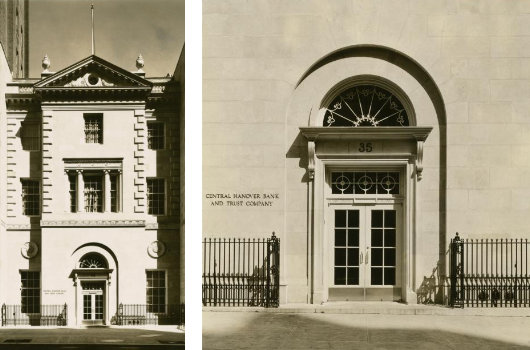
Passing by, as I sometimes do, the Chase branch bank at East 72nd St., I think to myself “There’s a fine establishment, in which I should keep my money”. The thought never jumps from theory to practice, however, as I am a patriot in everything but finance, and keep my florins safe with the Hongkong & Shanghai Bank instead. Nonetheless, it’s a handsome building, and the Central Hanover Bank & Trust Company should be commended for erecting it. Central Hanover merged with the Manufacturers Trust Company in 1961 to form Manufacturers Hanover (“Manny Hanny”), which was taken over by Chemical Bank in 1991, which was acquired by Chase Manhattan Bank in 1995, which merged with J.P. Morgan in 2000, and the consumer & commercial banking arm of J.P. Morgan Chase & Co. is now simply known as “Chase”.
While the original Chase National Bank was only formed in 1877, with all these mergers and acquisitions, “Chase” can now trace its lineage back to the foundation of the Bank of the Manhattan Company in 1799, the second oldest bank after the Bank of New York. But — would you believe it? — “Chase” is now headquartered not in the hallowed caverns of Wall Street but — wait for it — Chicago, Illinois!
Quo Vadis, Benedicte?
Roman Forum and Una Voce New York Event
October 19, 2008: 1:30—6:00 P.M.
Since the Catholic revival of the nineteenth century, the Papacy has found itself facing dangers on all fronts in its efforts to transform the world in Christ. On the one hand, this work has involved a need for protecting and deepening knowledge of the Deposit of Faith. On the other, it has entailed developing strategies for dealing with a globe filled with hostile visions of life that have nevertheless proven seductive to many Catholics. John Rao, Associate Professor of History at St. John’s University, discusses the historical development of the problem from the reign of Blessed Pius IX (1846-1878) until the near present; Christopher Ferrara, President of the American Catholic Lawyers Association, treats of it with respect to the specific difficulties of Pope Benedict XVI.
Let Louis XVI Rest in Peace; A Funeral Mass in Manhattan
By PETER STEINFELS | The New York Times | July 17, 1989
They came not to praise the French Revolution but to bury it.
In the place of tricolor bunting, there were the black vestments of an old-fashioned Roman Catholic funeral Mass. Instead of fireworks, there were the flickering candles of a Manhattan church. Instead of the “Marseillaise,” there was the rise and fall of Gregorian chant.
They came not to praise the French Revolution but to bury it. In the place of tricolor bunting, there were the black vestments of an old-fashioned Roman Catholic funeral Mass. Instead of fireworks, there were the flickering candles of a Manhattan church. Instead of the “Marseillaise,” there was the rise and fall of Gregorian chant.
Subway riders, New York City, 1914
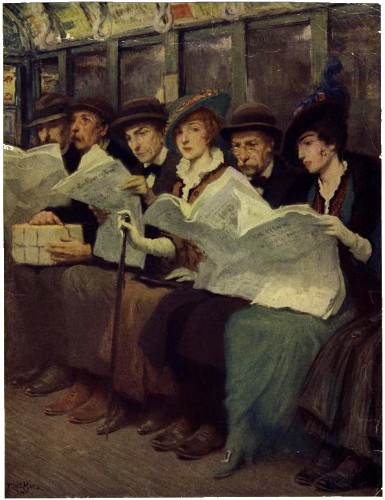
Francis Luis Mora, Subway riders, New York City, 1914
Print, 12½” x 9¼”
1914, New York Public Library
New York Sun will no longer shine for all
Center-right New York daily will cease printing at end of month
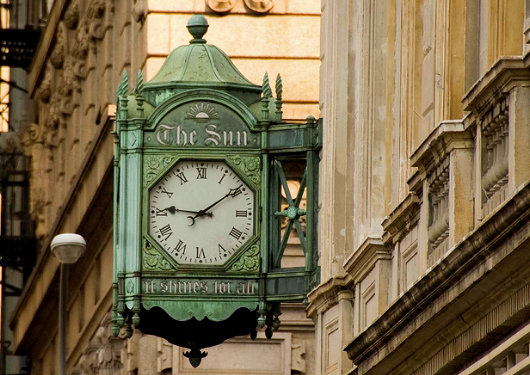
In a devastating blow to the intellectual life of the city, the New York Sun editor Seth Lipsky announced today that the small-but-influential daily newspaper will cease operations at the end of the month unless new investors can be found to put many millions of dollar into the revived title. The newspaper — known for its excellent arts & cultural coverage and willingness to lift the veil on corruption in addition to its hardcore neoconservative politics — is believed to be operating at a loss of tens of millions of dollars a year. Seth Lipsky announced the perilous state of the Sun in a letter to readers this morning:
The Great Club Revolution
What with all this democracy things will never be the same
 The Union Club |
By Cleveland Amory
American Heritage, December 1954, Vol. 6, Issue 1
In 1936 in New York City there occurred the 100th anniversary of the Union Club, oldest and most socially sacrosanct of New York’s gentlemen’s clubs. From all parts of this country and even from abroad there arrived, from lesser clubs, congratulatory messages, impressive gifts and particularly large offerings of floral tributes.
At the actual anniversary banquet, however, as so often happens in gentlemen’s clubs, there was, despite the dignity of the occasion, the severe speeches and the general sentimental atmosphere, a little over-drinking. And one member over-drank a little more than a little. Shortly before dessert he decided he had had enough, at least of the food, and he disappeared. Furthermore, he did not reappear.
Worried, some friends of his decided, after the banquet, to conduct a search. The faithful doorman in the hooded hallporter’s chair gave the news that no gentleman of that description had passed out, or rather by, him, and the friends redoubled their efforts. High and low they combed the missing member’s favorite haunts—the bar, the lounge, the card room, the billiard room, the locker room, the steam room, etc. One even tried, on an off-chance, the library. There, as usual, there was nothing but a seniority list of the Union’s ten oldest living members and a huge sign reading “SILENCE.”
Finally, in one of the upstairs bedrooms, they found the gentleman. He was lying on a bed, stretched out full length in his faultless white tie and tails, dead to this world.
A Rundbogenstil Library in New York
The handsome former Astor Library on Lafayette Street

One of my favorite buildings in all New York is the former Astor Library on Lafayette Street in Greenwich Village. Now the Public Theater, it is a superb example of the nineteenth-century German neo-romantic Rundbogenstil (“round-arch-style”) and one of the few remnants of that style in New York. The Astor Library was the legacy of John Jacob Astor, whose will provided for its establishment. Late in the nineteenth century, the Astor Library agreed to merge with the Lenox Library and the Tilden Trust to form the New York Public Library, one of the greatest libraries in the history of civilization. The building was bought by the Hebrew Immigrant Aid Society who tore out the book stacks and used it as a processing station for needy newcomers. In 1965, the HIAS sold it on to a developer who planned to demolish it, but, through a massive civic effort, Joseph Papp and his New York Shakespeare Festival purchased the building and turned it into the Public Theater.
Hic mihi patria est

The Fourth of July, we are told, is a day for celebrating the love of one’s country. Robert Harrington and I were sitting around one evening when we decided to found a guerrilla group. First, it needed a name; Front pour la libération de notre terre sacrée Amérique (or the FLNTSA) was a runner-up but we settled on the Village Green Preservation Society. Frowning upon the camouflage fatigues of most groups of this nature, we decided that our uniform would consist of tweed jackets, flat caps, and balaclavas.
But as our conversation continued we discovered, to our chagrin, that though we thought we were both from the United States of America, we were actually from entirely different countries. Robbo’s country is the nicer, rather horsey part of New Jersey near Princeton, whereas my homeland is mostly the part of New York between the Hudson and the Sound. We discovered we were fighting for the preservation of entirely different Village Greens, and that ma terre sacrée Amérique was entirely different from sa terre sacrée Amérique.
This is one of the problems of a “country” as large as the United States. I love my country, but what do I care about Montana or Texas or Alaska? I wish them well, to be sure, but they hardly seem to have much to do with my country. I once started to read a scaremongering article about the growing Mexicanization of California but I had to put it down after a few paragraphs because it didn’t seem to be anything I had to worry about. If southern California secedes and tries to join Mexico, well good for them! I’ll send them a bottle of champagne and get back in my hammock.
In The Napoleon of Notting Hill, Chesterton wrote:
In that spirit, I present to you below a map of my country, from Sleepy Hollow in the north, to Governors Island in the south. It is a mere approximation, as the borders are both indefinite and ever-shifting. Though highly populated, it is a bit on the small side, and I think I agree with Chesterton that that’s a good thing.

Abomination
This act of willful cultural vandalism is noxious in the sight of both God and Man and is a complete and utter abomination. Whoever is responsible for this should be hanged, drawn, and quartered, and buried at a crossroads with a stake through his heart.
Observe the beauty of this building at the corner of Harrison & Penn in Williamsburg, Brooklyn: its classic composition, its complete vernacular ease. And look at the cheap, tawdry, wrongly-colored brick used to hide and ultimately destroy this ordinary gem.
How can the perpetrator of this act sleep at night? It boggles the mind…
From “A Suburban Country Place”
Claremont, at the end of Riverside Drive, near the tomb of General Grant, suggests in a rather humble way what these mansions were, and in a very magnificent way what their outlooks were. Others linger, desecrated, here and there, closely pressed by new-laid brick and stone. And away up at the extreme tip of Manhattan there are still a few quiet, shady places which may call themselves suburban in the old and honorable sense. But everywhere else around the outskirts of Manhattan the term has gained an unattractive, hybrid meaning. To speak it with pleasure, New-Yorkers must apply it to those remoter regions which can be reached only by a railway journey of considerable length. And then it is incorrectly applied, for a real suburban place is rural in aspect, but urban in convenience — private, green, and peaceful in itself, yet close in touch with the true self of the town. …
“A Suburban Country Place”
The Century Magazine,
May 1897
Glass-plating the Coliseum
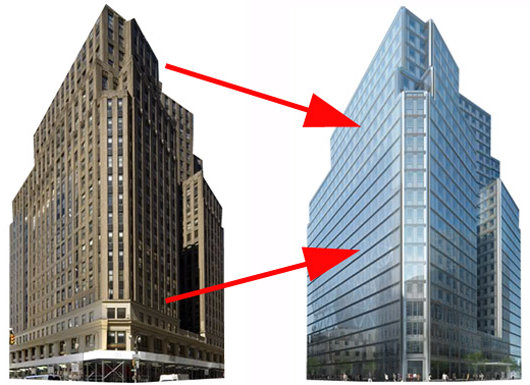
1775 Broadway, formerly the home of Coliseum Books (which I believe got its name from the splendid columns ringing the first two floors, as well as from the nearby now-demolished New York Coliseum), is to be glass-plated and re-addressed as “3 Columbus Circle”. As John Massengale commented, “Because if there’s anything New York City needs it’s another glass-covered office building…”.
New Yorker Elected Mayor of London

Congratulations to that most-honoured son of the Empire State, Mr. Alexander Boris de Pfeffel Johnson MP, more commonly known as Boris, on his election to the mayoralty of Greater London. Mr. Johnson was born on these sacred shores some forty-four years ago on a pleasant June day. Boris has politics in the blood as his father Stanley is a former Conservative MEP, but let us hope he does not take after his great-grandfather, Ali Kemal Bey, who made enough unfortunate decisions during his brief tenure as interior minister of the Ottoman Empire that he was knicked from the barber shop of the rather-smart Tokatlian Hotel in Constantinople and lynched shortly thereafter.
Strangely enough, this is not exactly the closest connection New York and London have ever had. Sir Gilbert Heathcote, 1st Baronet was Lord Mayor of London in 1710 while his brother Caleb Heathcote was Mayor of the City of New York, exhibiting how interconnected our transatlantic British world was in those days. Caleb Heathcote was also Lord of the Manor of Scarsdale, which is just five minutes north of here on the train. Created in 1703, Scarsdale was the last manor granted in the entire British Empire. There were about a dozen manorial lordships here in New York, bringing the proud heritage of feudalism to the New World. The Manor of Gardiner’s Island survives to this day as the only manor in America in which the land is still entirely owned by the descendants.
The bulk of manorial privileges (incorporating the pre-existing patroonships from the olden Dutch days) were, alas, abolished in the 1840s, with the final holdouts taken care of in some legislation of 1911, but the Lord of the Manor of Pelham was presented with a fatted calf each St. John’s Day from the City Council of New Rochelle (honoring the Huguenots’ agreement purchasing the land from the Pells) well into the twentieth century.
The Heathcote name survives, in Derbyshire I believe, but not in America. Caleb Heathcote married the daughter of Col. William Smith, Chief Justice of the Province of New York, but had only daughters.
And you thought subsidising the poor was bad…
Millions of tax dollars taken from hard-working Americans are going to subsidise one of the wealthiest school districts in the country
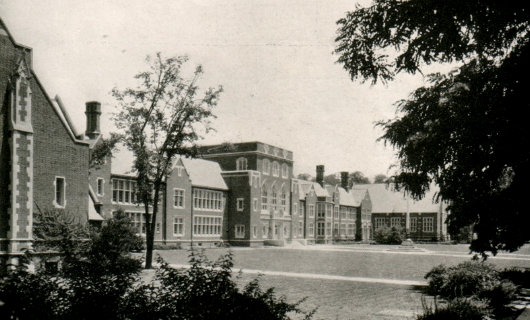
The Bronxville School (as it is called, since all grades from kindergarten to 12th are in the same building) ostensibly has a number of things going for it. It has a rather splendid collegiate gothic building in an excellent setting in one of the handsomest villages in all of the Empire State. Its school district is a mere square-mile, meaning most students can walk to school and it doesn’t even have a bus system. It has a private foundation funded independently by parents and alumni to support the school. What more could a public school possibly need?
Well, according to the geniuses down in Washington, D.C., $5.4 million in federal grants. The school, you see, is built on a site which frequently floods. Our main street in Bronxville is called Pondfield Road for a reason: the field with the pond is the open space where the school now stands. It’s been flooding for decades and so floods should come as no surprise. The nor’easter that blew through town a year ago flooded the school severely, closing it for over a week. The flooding was particularly bad during the last nor’easter because the school had spent a great deal of money (privately-raised, not from the public purse) to replace its natural football field with a lower-maintenance fake turf alternative. They did this instead of saving the money for, oh, say, one of those floods that happens every so often.
The money has been secured from the Federal Emergency Management Agency by our congresswoman, Nita Lowey (D). “When a natural disaster occurs, the federal government has a responsibility to help communities recover,” said Lowey, who neglected to provide any legal or moral backing for such an untruthful and baseless claim.
The school district of one of the wealthiest communities in the country is filching off the hard-working people of America in order to clean up the mess that is a direct result of its own poor spending decisions and inability to plan properly. Is there no shame?
Our Lady of Esperanza
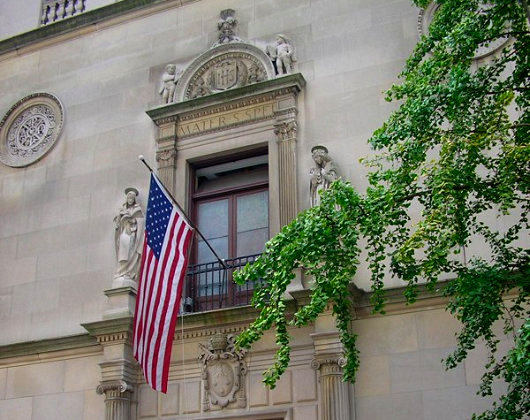
The Church of Our Lady of Esperanza, 156th Street & Broadway. The Church was built by Archer Huntington at the urging of Doña Manuela de Laverrerie de Barril and designed by Huntington’s brother Charles. The sanctuary lamp was a gift from King Alfonso XIII of Spain. The present façade dates from 1924, when the Church was expanded under the direction of Lawrence G. White, the son of Stanford White of McKim Mead & White and himself a partner in his father’s firm.
The right direction
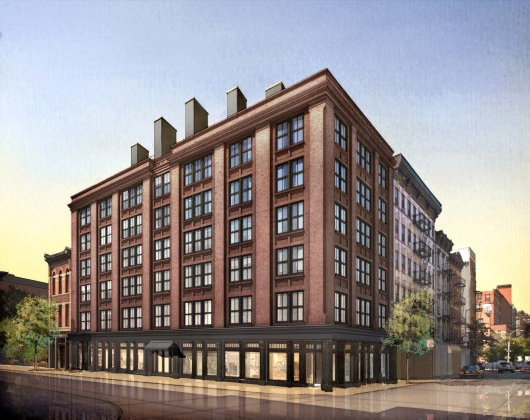
What’s this? A building built from the ground up by a developer in New York, and designed to look like a New York building? Something to look forward to at 211 Elizabeth Street.
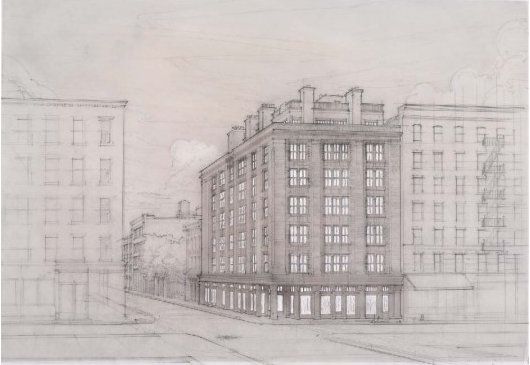
(more…)
The Late Great Bank of New York

Doesn’t it often seem that as soon as something you actually like comes along, it’s only a short amount of time before it’s gone again? This is how I feel about the latest, and indeed last, logo and general visual identity of the Bank of New York. Readers are no doubt aware that the Bank of New York is the oldest bank in America (founded by Alexander Hamilton) and that its was the first share traded on the New York Stock Exchange when that great financial market was founded beneath a buttonwood tree in 1792.
In 2005, the Bank of New York finally dumped their 1980’s-feel, dated-but-traditional logo in favor of a new design put together by the New York brand house of Lippincott (then still known as Lippincott Mercer). The logo suggested an old stock or bank note but its polychromatic scheme gave it a modern vibrancy. The adjacent logotype was along similar lines: “Bank” and “New York” in a tasteful, restrained modern with “The” and “of” in a delightfully traditional fluid colonial script.

But on July 1, 2007, the ancient Bank of New York merged with a foreign interloper, the Mellon Financial Corporation of Pennsylvania and the disgusting hybrid child of the marriage is cumbersomely monikered: “The Bank of New York Mellon”. How awkward and ungainly! Along with the merger came a new logo, also designed by Lippincott, which you can see on the BNYM website. This pitiful modern arrowhead design says little, other than one might suffer bodily harm at its handling.
The 2005 Bank of New York logo evoked a sense of solidity. “I have deep roots and firm foundations,” it seemed to say, “but am nonetheless modern and adapting to change”. Think of the feel, the smell, of a worn bank note and then compare it to the dull, prickly arrowhead which threatens injury. The old logo you stick in you pocket and gain a sense of security from. The new logo you worry a ninja might hurl at you.
It was an error even to change the name, if you ask me. “The Bank of New York” has such a simplicity and a solidity to it, which the new name rather lacks. It is just like the old New York law firm of Dewey Ballantine, which suffered a takeover recently and is now known as “Dewey and LeBoeuf”. Rather sounds like a pair of huckster Louisiana lawyers hoping to make a few off the innocent inhabitants of the Bayou. So stick to the tried and the true, folks. It usually works.
Spring hath duly sprung
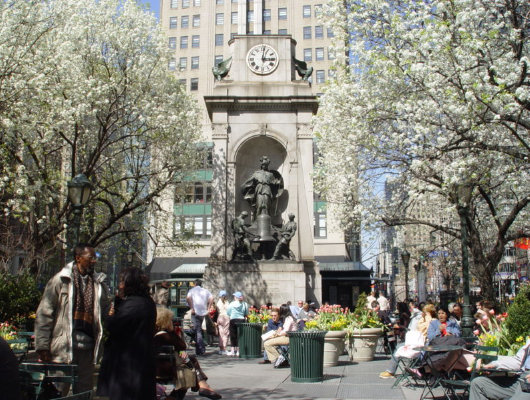
Herald Square, at the confluence of Broadway and the Avenue of the Americas.
In Old New York
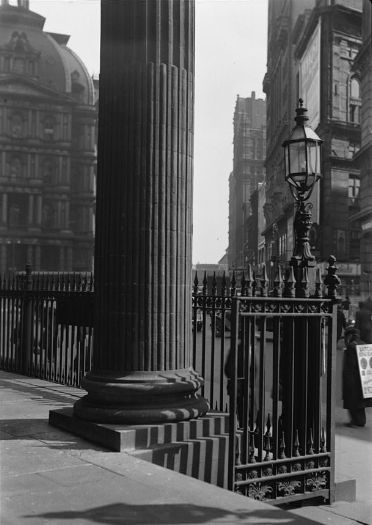
The steps of St. Paul’s Chapel, Broadway, looking towards Park Row, March 1937.
Upcoming Events
April 26, 2008 (Saturday)
The Birthday of Rome: 753 B.C. – 2003 A.D.
The Roman Forum Spring Ball
7:00pm – midnight
Catholic Center at New York University
238 Thompson Street
(between Washington Square South & West 3rd Street)
A, B, C, D, E, F, V trains to West 4th St.; R to 8th St.; 6 to Bleecker St.
7-Piece Rich Siegel Ballroom Orchestra
Grand Imperial Buffet and Dessert
Well Done Roma! Festivities and Spontaneous Outburst of Joy, 10:00 pm.
According to tradition, Romulus took up his trusty plow and marked out a sulcus around “Shepherds’ Hill” on the twelfth day before the Kalends of May, i.e., a.d. XII Kal. Mai-a date which, give or take eleven or twelve days, roughly corresponds to what we call April 21st. Conveniently, the date was also the festival of the shepherd goddess Pales (the Parilia), in whose honor the hill, chosen by Romulus, had been named the Palatine.
When the festival was adopted by city dwellers, the date was set to coincide with the date of the traditional founding of Rome. Each area of Rome set up festivities, much like a block party. Bonfires were set onto which offerings were thrown. The event concluded with a bountiful feast set up out of doors. Catholics can also commemorate the day due to Rome’s Christian meaning.
Two songs will be sung at the 10:00 P.M. festivities: The papal hymn, Roma Immortale, and Rome’s Birthday Song, the latter to the tune of Oklahoma, with lyrics by Judy Hallet.
For further information please contact the Roman Forum (dvhinstitute@aol.com or call 212-645-2971).
COST
$50 per person
(Children 16 and under, free)
Reserve by April 21
ATTIRE
Suit and tie or dinner jacket for the men
Checks payable to:
The Roman Forum
11 Carmine Street, 2C
New York, NY, 10014
May 3, 2008 (Saturday)
The Glass of Absinthe and the Rules of the Game
Part two of the Roman Forum’s Modern Image & Catholic Truth series
9:00am – 5:00pm
Catholic Center at New York University
238 Thompson Street
(between Washington Square South & West 3rd Street)
A, B, C, D, E, F, V trains to West 4th St.; R to 8th St.; 6 to Bleecker St.
Modern man has a positive image of himself that has been shaped and very effectively propagandized since the time of the Renaissance. The Roman Forum’s Modern Image and Catholic Truth series explores the gap between this image and the true predicament in which both the individual and contemporary society as a whole now find themselves imprisoned.
Part Two: The Glass of Absinthe and the Rules of the Game
This year’s series began in November with a conference called The Sleep of Reason, designed to underline the fact that modern naturalism ends with the destruction of the rational in man, achieved in a variety of different ways depending upon the particular approaches of the thinkers and activists concerned.
The Glass of Absinthe and The Rules of the Game were originally intended to be two separate conferences—the first focusing on the destructive aspects of the naturalist separation of the individual from society and his own past; the second on the intellectual, artistic, psychological and socio-political obstacles placed in the path of identification of the disease that afflicts us. These have now been combined into one session— the last Roman Forum event in the United States in the 2007-2008 academic year.
9:00 – 10:00 am
Registration and coffee hour
10:00 – 11:00 am
The Glass of Absinthe and the Rules of the Game
Dr. John C. Rao
St. John’s University, Director of Roman Forum
11:15 am – 12:15 pm
The Empire of Nothingness
Christopher A. Ferrara, Esq.
President, American Catholic Lawyers Association
12:15 – 1:45 pm
Luncheon
1:45 – 2:45 pm
Citycraft and Soulcraft
Dino Marcantonio, AIA
Architect and Lecturer at the Yale School of Architecture
3:00 – 4:00 pm
Reason Gone Mad
James Kalb, Esq.
International Catholic lecturer and writer; author of The Tyranny of Liberalism: Understanding and Overcoming Administered Freedom, Inquisitorial Tolerance, and Equality by Command (Fall, 2008, ISI Books).
4:00 – 5:00 pm
General Discussion
For further information please contact the Roman Forum (dvhinstitute@aol.com or call 212-645-2971).
COST
$35: Reserve by April 28, entrance & luncheon
$10: Pay at the door, entrance alone
Checks payable to:
The Roman Forum
11 Carmine Street, 2C
New York, NY, 10014
Sniffen Court
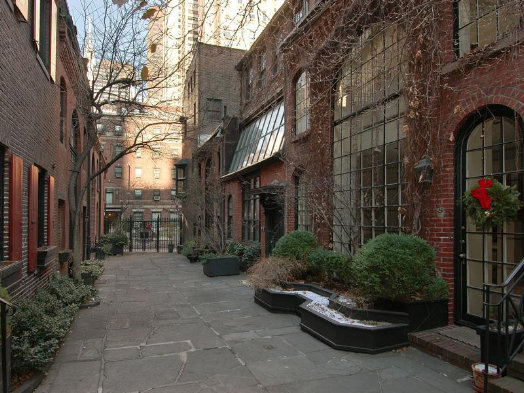
A PROPERTY IN Sniffen Court coming on the market is a rare event, but two up for grabs at the same time must be a first. Like Grove Court, MacDougal Alley, or Washington Mews, this little alleyway is one of the most desirable of those little nooks and crannies that hide amidst the hurly-burly of Manhattan. Tradition holds that Sniffen Court was built as stables by one John Sniffen around the time of the Civil War, but there is no record of any Sniffen ever having owned the properties (some therefore presume he was the architect). They were converted, like many mews around the city, from stables to residences in the 1920s and all have gradually adapted and changed since then.
Search
Instagram: @andcusack
Click here for my Instagram photos.Most Recent Posts
- Faithful Shepherd of the Falklands April 8, 2025
- Articles of Note: 8 April 2025 April 8, 2025
- Proportionality Destroys Representation April 8, 2025
- Sag Harbor Cinema March 26, 2025
- Teutonic Takeover March 10, 2025
Most Recent Comments
Book Wishlist
Monthly Archives
Categories


